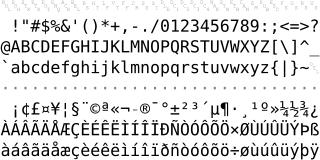Extended Binary Coded Decimal Interchange Code is an eight-bit character encoding used mainly on IBM mainframe and IBM midrange computer operating systems. It descended from the code used with punched cards and the corresponding six-bit binary-coded decimal code used with most of IBM's computer peripherals of the late 1950s and early 1960s. It is supported by various non-IBM platforms, such as Fujitsu-Siemens' BS2000/OSD, OS-IV, MSP, and MSP-EX, the SDS Sigma series, Unisys VS/9, Unisys MCP and ICL VME.

ISO/IEC 8859-1:1998, Information technology — 8-bit single-byte coded graphic character sets — Part 1: Latin alphabet No. 1, is part of the ISO/IEC 8859 series of ASCII-based standard character encodings, first edition published in 1987. ISO/IEC 8859-1 encodes what it refers to as "Latin alphabet no. 1", consisting of 191 characters from the Latin script. This character-encoding scheme is used throughout the Americas, Western Europe, Oceania, and much of Africa. It is the basis for some popular 8-bit character sets and the first two blocks of characters in Unicode.
ISO/IEC 8859 is a joint ISO and IEC series of standards for 8-bit character encodings. The series of standards consists of numbered parts, such as ISO/IEC 8859-1, ISO/IEC 8859-2, etc. There are 15 parts, excluding the abandoned ISO/IEC 8859-12. The ISO working group maintaining this series of standards has been disbanded.

Windows-1252 or CP-1252 is a single-byte character encoding of the Latin alphabet, that was used by default in e.g. Microsoft Windows for English and many (European) languages including Spanish, Portuguese, French, and German. This character-encoding scheme is used throughout the Americas, Western Europe, Oceania, and much of Africa. Windows now uses Unicode character sets by default.

The SG-1000 is a home video game console manufactured by Sega. It was Sega's first entry into the home video game hardware business. Developed in response to a downturn in arcades starting in 1982, the SG-1000 was created on the advice of Hayao Nakayama, president of Sega's Japanese arm, and was released on July 15, 1983, the same day that Nintendo released the Family Computer in Japan. It also saw limited release in Australia and New Zealand.
The Multinational Character Set is a character encoding created in 1983 by Digital Equipment Corporation (DEC) for use in the popular VT220 terminal. It was an 8-bit extension of ASCII that added accented characters, currency symbols, and other character glyphs missing from 7-bit ASCII. It is only one of the code pages implemented for the VT220 National Replacement Character Set (NRCS). MCS is registered as IBM code page/CCSID 1100 since 1992. Depending on associated sorting Oracle calls it WE8DEC, N8DEC, DK8DEC, S8DEC, or SF8DEC.
Magnetic ink character recognition code, known in short as MICR code, is a character recognition technology used mainly by the banking industry to streamline the processing and clearance of cheques and other documents. MICR encoding, called the MICR line, is at the bottom of cheques and other vouchers and typically includes the document-type indicator, bank code, bank account number, cheque number, cheque amount and a control indicator. The format for the bank code and bank account number is country-specific.
ISO/IEC 8859-10:1998, Information technology — 8-bit single-byte coded graphic character sets — Part 10: Latin alphabet No. 6, is part of the ISO/IEC 8859 series of ASCII-based standard character encodings, first edition published in 1992. It is informally referred to as Latin-6. It was designed to cover the Nordic languages, deemed of more use for them than ISO 8859-4.
The Ideographic Research Group (IRG), formerly called the Ideographic Rapporteur Group, is a subgroup of Working Group 2 (WG2) of ISO/IEC JTC 1/SC 2, the subcommittee of the Joint Technical Committee of ISO and IEC which is responsible for developing standards within the field of coded character sets. IRG is composed of experts from China, Japan, South Korea, Vietnam and other countries and regions that use Han characters, as well as experts representing the Unicode Consortium. The group is responsible for coordinating the addition of new CJK unified ideographs to the Universal Multiple-Octet Coded Character Set and the Unicode Standard. The group meets twice a year for 4-5 days each time, and reports its activity to the subsequent meeting of WG2.
In Unicode, a Private Use Area (PUA) is a range of code points that, by definition, will not be assigned characters by the Unicode Consortium. Three private use areas are defined: one in the Basic Multilingual Plane, and one each in, and nearly covering, planes 15 and 16. The code points in these areas cannot be considered as standardized characters in Unicode itself. They are intentionally left undefined so that third parties may define their own characters without conflicting with Unicode Consortium assignments. Under the Unicode Stability Policy, the Private Use Areas will remain allocated for that purpose in all future Unicode versions.
The C0 and C1 control code or control character sets define control codes for use in text by computer systems that use ASCII and derivatives of ASCII. The codes represent additional information about the text, such as the position of a cursor, an instruction to start a new line, or a message that the text has been received.
UTF-1 is a method of transforming ISO/IEC 10646/Unicode into a stream of bytes. Its design does not provide self-synchronization, which makes searching for substrings and error recovery difficult. It reuses the ASCII printing characters for multi-byte encodings, making it unsuited for some uses. UTF-1 is also slow to encode or decode due to its use of division and multiplication by a number which is not a power of 2. Due to these issues, it did not gain acceptance and was quickly replaced by UTF-8.
ISO 6438:1983, Documentation — African coded character set for bibliographic information interchange, is an ISO standard for an 8-bit character encoding for African languages. Developed separately from the African reference alphabet but apparently based on the same data sets, it has had little use; its forms are retained Unicode.
Many Unicode characters are used to control the interpretation or display of text, but these characters themselves have no visual or spatial representation. For example, the null character is used in C-programming application environments to indicate the end of a string of characters. In this way, these programs only require a single starting memory address for a string, since the string ends once the program reads the null character.
The Universal Coded Character Set is a standard set of characters defined by the international standard ISO/IEC 10646, Information technology — Universal Coded Character Set (UCS), which is the basis of many character encodings, improving as characters from previously unrepresented typing systems are added.
The Sega Card, known in Japan as Sega My Card, is a memory card format used as game storage for the SG-1000/SC-3000 and the Mark III/Master System. Produced from 1983 to 1987 by Mitsubishi Plastics, the cards are plugged into onboard cardslots or into compatible adapters. Several versions of the format were created, including a rewritable one that allows new titles to be downloaded to a card. While substantially cheaper to produce than cartridges, the storage limitations of the format resulted in Sega exclusively distributing games on cartridges. Despite the failure of the Sega Card, NEC found more success with its own memory card format, the HuCard, which was the primary storage medium for its PC Engine game console.

Sega Hard Girls is a Japanese multimedia project produced as a collaboration between ASCII Media Works' Dengeki Bunko imprint and video game company Sega. The project re-imagines various Sega video game consoles as anthropomorphized goddesses who appear all over modern Japan. The project has inspired a light novel series written by Tōru Shiwasu with illustrations by Kei, which was serialized in ASCII Media Works' Dengeki Bunko Magazine between 2013 and 2014, and an anime television series adaptation titled Hi-sCoool! SeHa Girls by TMS Entertainment, which aired in Japan between October and December 2014. A crossover video game with Idea Factory's Hyperdimension Neptunia franchise, Superdimension Neptune VS Sega Hard Girls, was released for the PlayStation Vita in Japan in November 2015, and in North America and Europe in October 2016.
The ISO 2033:1983 standard defines character sets for use with Optical Character Recognition or Magnetic Ink Character Recognition systems. The Japanese standard JIS X 9010:1984 is closely related.
ISO 5426 is a character set developed by ISO, similar to ISO/IEC 6937. It was first published in 1983.



